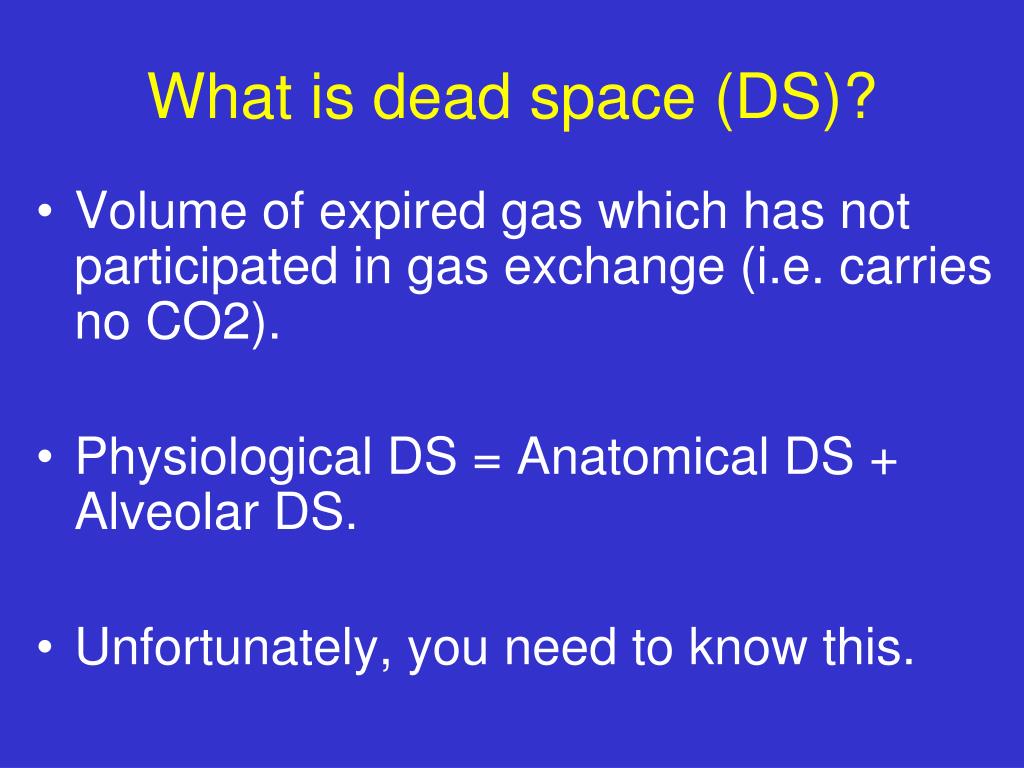
Ventilation is generally expressed as volume of air times a respiratory rate. In respiratory physiology, the ventilation rate is the rate at which gas enters or leaves the lung. The effect on PaCO2 is less as patient weight increases, but these data suggest it can be significant for typical circuit components up to at least 17 kg or aged 36 months.\) Increasing apparatus Vd can lead to exponential increases in PaCO2 and/or RR required to maintain normal PaCO2. Hg increased exponentially with increasing dead space.Similarly, RR required to maintain PaCO2 of 40 mm For smaller patients, the PaCO2 increased more rapidly for small changes in Vd than that in larger patients. PaCO2 increased exponentially with increasing apparatus dead space. The apparatus Vd of typical device arrangements ranged from 8 to 55 mL, and these values were used for the dead space values in the model.
 Hg was determined as dead space increased. Rearranging the Bohr equation, the RR required to maintain PaCO2 of 40 mm The relationship between PaCO2 and dead space was determined for increasing Vd. Initial conditions were Vt = 8 mL/kg, Vd/Vt = 0.3, and a RR of 20 breaths per minute. VCO2 was estimated by using Brody's equation for humans aged up to 36 months, (VCO2 = 5.56*(wt)), where weight is in kilogram. The relationship between the fraction of alveolar CO2 (FaCO2) and dead space volume (Vd) was derived from the Bohr equation, FaCO2 = VCO2/(RR*(Vt - Vd)), where VCO2 is CO2 production, RR is respiratory rate, and Vt is tidal volume. Apparatus volumes for typical devices were obtained from the manufacturer or measured by the volume of water required to fill the device. The effect of changes in dead space on arterial CO2 (PaCO2) and required minute ventilation were calculated for patients weighing 2 to 17 kg that corresponds to 0 to 36 months of age. Children are especially vulnerable because small increases in apparatus dead space can significantly increase dead space to tidal volume ratio (Vd/Vt). Apparatus dead space increases dead space volume, causing either increased PaCO2 or the need to increase minute ventilation to maintain normocapnia.
Hg was determined as dead space increased. Rearranging the Bohr equation, the RR required to maintain PaCO2 of 40 mm The relationship between PaCO2 and dead space was determined for increasing Vd. Initial conditions were Vt = 8 mL/kg, Vd/Vt = 0.3, and a RR of 20 breaths per minute. VCO2 was estimated by using Brody's equation for humans aged up to 36 months, (VCO2 = 5.56*(wt)), where weight is in kilogram. The relationship between the fraction of alveolar CO2 (FaCO2) and dead space volume (Vd) was derived from the Bohr equation, FaCO2 = VCO2/(RR*(Vt - Vd)), where VCO2 is CO2 production, RR is respiratory rate, and Vt is tidal volume. Apparatus volumes for typical devices were obtained from the manufacturer or measured by the volume of water required to fill the device. The effect of changes in dead space on arterial CO2 (PaCO2) and required minute ventilation were calculated for patients weighing 2 to 17 kg that corresponds to 0 to 36 months of age. Children are especially vulnerable because small increases in apparatus dead space can significantly increase dead space to tidal volume ratio (Vd/Vt). Apparatus dead space increases dead space volume, causing either increased PaCO2 or the need to increase minute ventilation to maintain normocapnia. 
Physiologic dead space is defined as the volume of the lung where gas exchange does not occur.






 0 kommentar(er)
0 kommentar(er)
